Analysis of Accounting and Financial Duties in Decision Making
VerifiedAdded on 2023/06/10
|13
|3479
|321
Report
AI Summary
This report provides an overview of the significance of accounting and financial duties within a company, focusing on their impact on decision-making processes. It begins by outlining the importance of accounting and finance in managing cash flow, trade, and administration, emphasizing their role in assessing a company's financial performance and long-term viability. The report then delves into the specific financial and accountancy duties of Panini Limited, a bread production company, including gaining a strategic edge, maintaining records of money, evaluating monetary results, and handling tax documentation. It further examines the functions of the financial division, such as managing dividends, investments, working capital, and overall financial performance, as well as the accounting department's responsibilities in maintaining transaction records, management accounting, tax compliance, financial accounting, and auditing. The report also calculates and discusses various financial ratios for Panini Limited, including gross profit margin, operating profit margin, return on capital employed, current ratio, quick ratio, and inventory turnover ratio, analyzing their implications for the company's financial health and operational efficiency.

FINANCIAL
DECISION MAKING
DECISION MAKING
Paraphrase This Document
Need a fresh take? Get an instant paraphrase of this document with our AI Paraphraser
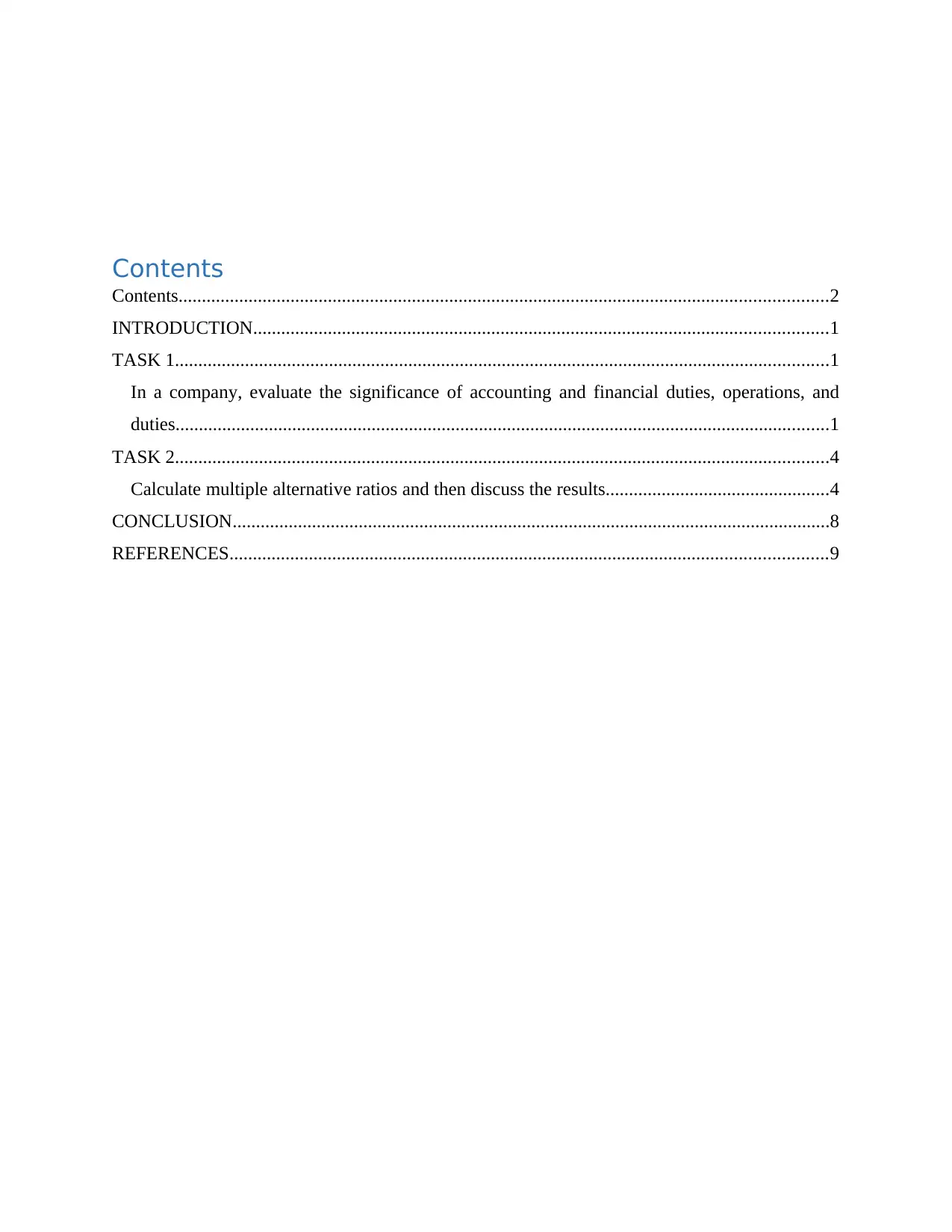
Contents
Contents...........................................................................................................................................2
INTRODUCTION...........................................................................................................................1
TASK 1............................................................................................................................................1
In a company, evaluate the significance of accounting and financial duties, operations, and
duties............................................................................................................................................1
TASK 2............................................................................................................................................4
Calculate multiple alternative ratios and then discuss the results................................................4
CONCLUSION................................................................................................................................8
REFERENCES................................................................................................................................9
Contents...........................................................................................................................................2
INTRODUCTION...........................................................................................................................1
TASK 1............................................................................................................................................1
In a company, evaluate the significance of accounting and financial duties, operations, and
duties............................................................................................................................................1
TASK 2............................................................................................................................................4
Calculate multiple alternative ratios and then discuss the results................................................4
CONCLUSION................................................................................................................................8
REFERENCES................................................................................................................................9

⊘ This is a preview!⊘
Do you want full access?
Subscribe today to unlock all pages.

Trusted by 1+ million students worldwide
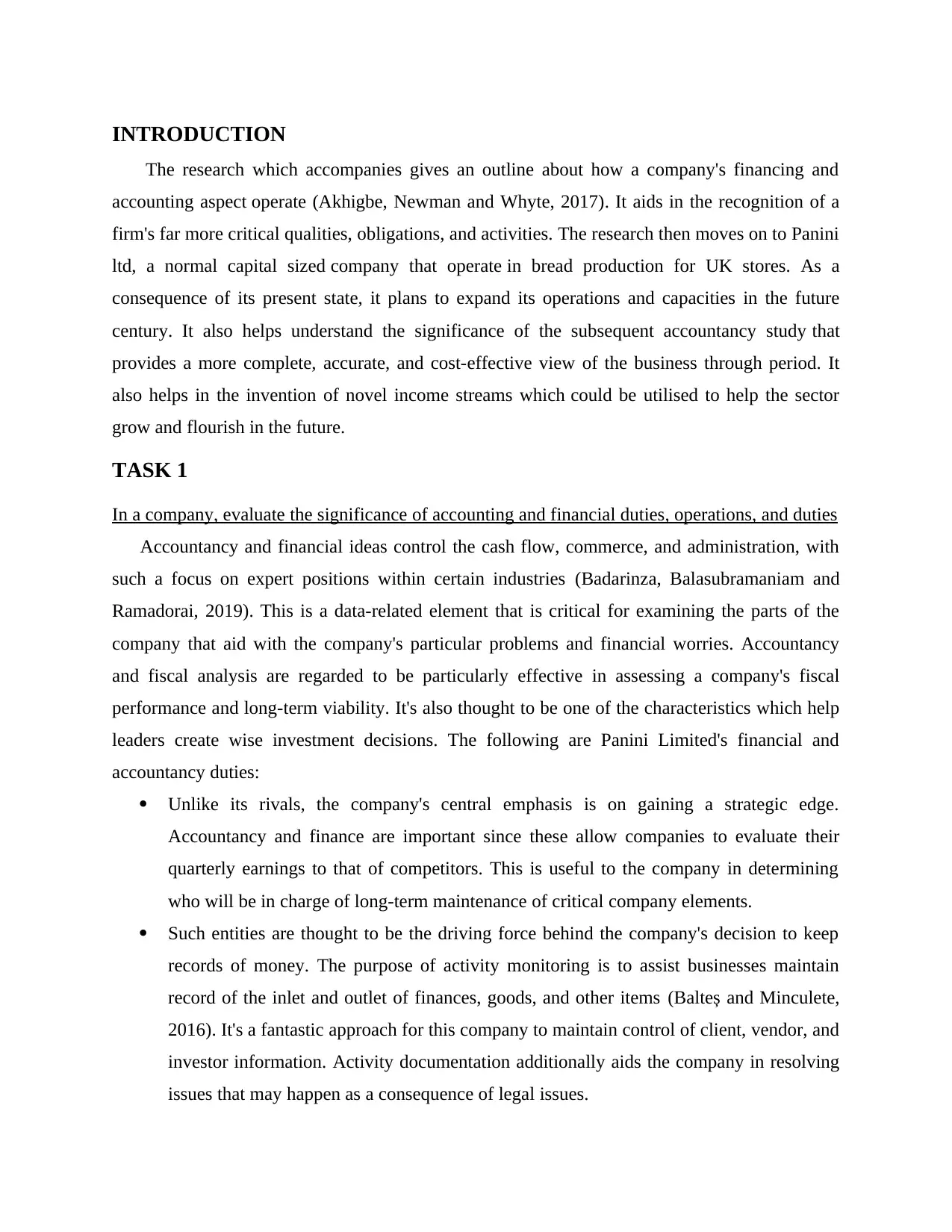
INTRODUCTION
The research which accompanies gives an outline about how a company's financing and
accounting aspect operate (Akhigbe, Newman and Whyte, 2017). It aids in the recognition of a
firm's far more critical qualities, obligations, and activities. The research then moves on to Panini
ltd, a normal capital sized company that operate in bread production for UK stores. As a
consequence of its present state, it plans to expand its operations and capacities in the future
century. It also helps understand the significance of the subsequent accountancy study that
provides a more complete, accurate, and cost-effective view of the business through period. It
also helps in the invention of novel income streams which could be utilised to help the sector
grow and flourish in the future.
TASK 1
In a company, evaluate the significance of accounting and financial duties, operations, and duties
Accountancy and financial ideas control the cash flow, commerce, and administration, with
such a focus on expert positions within certain industries (Badarinza, Balasubramaniam and
Ramadorai, 2019). This is a data-related element that is critical for examining the parts of the
company that aid with the company's particular problems and financial worries. Accountancy
and fiscal analysis are regarded to be particularly effective in assessing a company's fiscal
performance and long-term viability. It's also thought to be one of the characteristics which help
leaders create wise investment decisions. The following are Panini Limited's financial and
accountancy duties:
Unlike its rivals, the company's central emphasis is on gaining a strategic edge.
Accountancy and finance are important since these allow companies to evaluate their
quarterly earnings to that of competitors. This is useful to the company in determining
who will be in charge of long-term maintenance of critical company elements.
Such entities are thought to be the driving force behind the company's decision to keep
records of money. The purpose of activity monitoring is to assist businesses maintain
record of the inlet and outlet of finances, goods, and other items (Balteș and Minculete,
2016). It's a fantastic approach for this company to maintain control of client, vendor, and
investor information. Activity documentation additionally aids the company in resolving
issues that may happen as a consequence of legal issues.
The research which accompanies gives an outline about how a company's financing and
accounting aspect operate (Akhigbe, Newman and Whyte, 2017). It aids in the recognition of a
firm's far more critical qualities, obligations, and activities. The research then moves on to Panini
ltd, a normal capital sized company that operate in bread production for UK stores. As a
consequence of its present state, it plans to expand its operations and capacities in the future
century. It also helps understand the significance of the subsequent accountancy study that
provides a more complete, accurate, and cost-effective view of the business through period. It
also helps in the invention of novel income streams which could be utilised to help the sector
grow and flourish in the future.
TASK 1
In a company, evaluate the significance of accounting and financial duties, operations, and duties
Accountancy and financial ideas control the cash flow, commerce, and administration, with
such a focus on expert positions within certain industries (Badarinza, Balasubramaniam and
Ramadorai, 2019). This is a data-related element that is critical for examining the parts of the
company that aid with the company's particular problems and financial worries. Accountancy
and fiscal analysis are regarded to be particularly effective in assessing a company's fiscal
performance and long-term viability. It's also thought to be one of the characteristics which help
leaders create wise investment decisions. The following are Panini Limited's financial and
accountancy duties:
Unlike its rivals, the company's central emphasis is on gaining a strategic edge.
Accountancy and finance are important since these allow companies to evaluate their
quarterly earnings to that of competitors. This is useful to the company in determining
who will be in charge of long-term maintenance of critical company elements.
Such entities are thought to be the driving force behind the company's decision to keep
records of money. The purpose of activity monitoring is to assist businesses maintain
record of the inlet and outlet of finances, goods, and other items (Balteș and Minculete,
2016). It's a fantastic approach for this company to maintain control of client, vendor, and
investor information. Activity documentation additionally aids the company in resolving
issues that may happen as a consequence of legal issues.
Paraphrase This Document
Need a fresh take? Get an instant paraphrase of this document with our AI Paraphraser
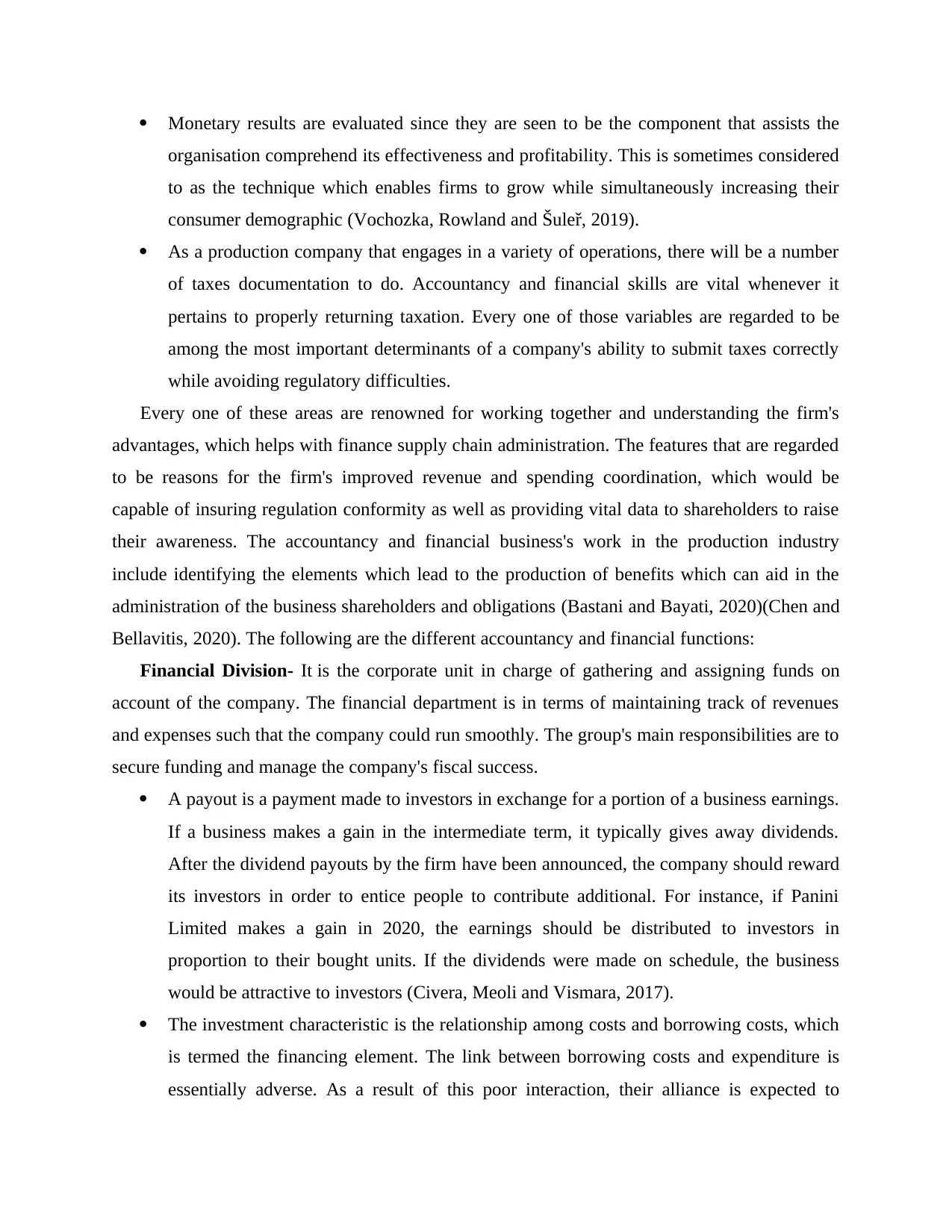
Monetary results are evaluated since they are seen to be the component that assists the
organisation comprehend its effectiveness and profitability. This is sometimes considered
to as the technique which enables firms to grow while simultaneously increasing their
consumer demographic (Vochozka, Rowland and Šuleř, 2019).
As a production company that engages in a variety of operations, there will be a number
of taxes documentation to do. Accountancy and financial skills are vital whenever it
pertains to properly returning taxation. Every one of those variables are regarded to be
among the most important determinants of a company's ability to submit taxes correctly
while avoiding regulatory difficulties.
Every one of these areas are renowned for working together and understanding the firm's
advantages, which helps with finance supply chain administration. The features that are regarded
to be reasons for the firm's improved revenue and spending coordination, which would be
capable of insuring regulation conformity as well as providing vital data to shareholders to raise
their awareness. The accountancy and financial business's work in the production industry
include identifying the elements which lead to the production of benefits which can aid in the
administration of the business shareholders and obligations (Bastani and Bayati, 2020)(Chen and
Bellavitis, 2020). The following are the different accountancy and financial functions:
Financial Division- It is the corporate unit in charge of gathering and assigning funds on
account of the company. The financial department is in terms of maintaining track of revenues
and expenses such that the company could run smoothly. The group's main responsibilities are to
secure funding and manage the company's fiscal success.
A payout is a payment made to investors in exchange for a portion of a business earnings.
If a business makes a gain in the intermediate term, it typically gives away dividends.
After the dividend payouts by the firm have been announced, the company should reward
its investors in order to entice people to contribute additional. For instance, if Panini
Limited makes a gain in 2020, the earnings should be distributed to investors in
proportion to their bought units. If the dividends were made on schedule, the business
would be attractive to investors (Civera, Meoli and Vismara, 2017).
The investment characteristic is the relationship among costs and borrowing costs, which
is termed the financing element. The link between borrowing costs and expenditure is
essentially adverse. As a result of this poor interaction, their alliance is expected to
organisation comprehend its effectiveness and profitability. This is sometimes considered
to as the technique which enables firms to grow while simultaneously increasing their
consumer demographic (Vochozka, Rowland and Šuleř, 2019).
As a production company that engages in a variety of operations, there will be a number
of taxes documentation to do. Accountancy and financial skills are vital whenever it
pertains to properly returning taxation. Every one of those variables are regarded to be
among the most important determinants of a company's ability to submit taxes correctly
while avoiding regulatory difficulties.
Every one of these areas are renowned for working together and understanding the firm's
advantages, which helps with finance supply chain administration. The features that are regarded
to be reasons for the firm's improved revenue and spending coordination, which would be
capable of insuring regulation conformity as well as providing vital data to shareholders to raise
their awareness. The accountancy and financial business's work in the production industry
include identifying the elements which lead to the production of benefits which can aid in the
administration of the business shareholders and obligations (Bastani and Bayati, 2020)(Chen and
Bellavitis, 2020). The following are the different accountancy and financial functions:
Financial Division- It is the corporate unit in charge of gathering and assigning funds on
account of the company. The financial department is in terms of maintaining track of revenues
and expenses such that the company could run smoothly. The group's main responsibilities are to
secure funding and manage the company's fiscal success.
A payout is a payment made to investors in exchange for a portion of a business earnings.
If a business makes a gain in the intermediate term, it typically gives away dividends.
After the dividend payouts by the firm have been announced, the company should reward
its investors in order to entice people to contribute additional. For instance, if Panini
Limited makes a gain in 2020, the earnings should be distributed to investors in
proportion to their bought units. If the dividends were made on schedule, the business
would be attractive to investors (Civera, Meoli and Vismara, 2017).
The investment characteristic is the relationship among costs and borrowing costs, which
is termed the financing element. The link between borrowing costs and expenditure is
essentially adverse. As a result of this poor interaction, their alliance is expected to
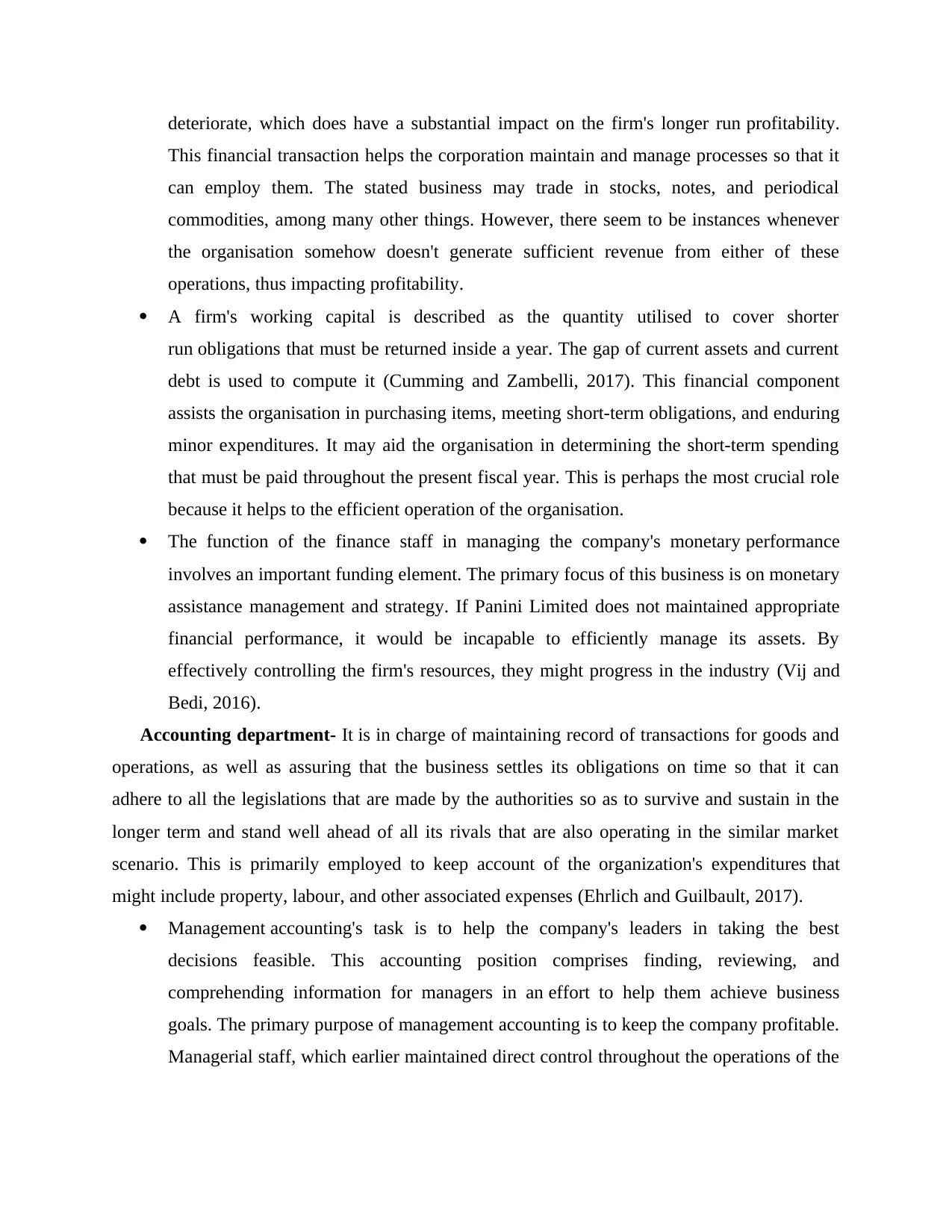
deteriorate, which does have a substantial impact on the firm's longer run profitability.
This financial transaction helps the corporation maintain and manage processes so that it
can employ them. The stated business may trade in stocks, notes, and periodical
commodities, among many other things. However, there seem to be instances whenever
the organisation somehow doesn't generate sufficient revenue from either of these
operations, thus impacting profitability.
A firm's working capital is described as the quantity utilised to cover shorter
run obligations that must be returned inside a year. The gap of current assets and current
debt is used to compute it (Cumming and Zambelli, 2017). This financial component
assists the organisation in purchasing items, meeting short-term obligations, and enduring
minor expenditures. It may aid the organisation in determining the short-term spending
that must be paid throughout the present fiscal year. This is perhaps the most crucial role
because it helps to the efficient operation of the organisation.
The function of the finance staff in managing the company's monetary performance
involves an important funding element. The primary focus of this business is on monetary
assistance management and strategy. If Panini Limited does not maintained appropriate
financial performance, it would be incapable to efficiently manage its assets. By
effectively controlling the firm's resources, they might progress in the industry (Vij and
Bedi, 2016).
Accounting department- It is in charge of maintaining record of transactions for goods and
operations, as well as assuring that the business settles its obligations on time so that it can
adhere to all the legislations that are made by the authorities so as to survive and sustain in the
longer term and stand well ahead of all its rivals that are also operating in the similar market
scenario. This is primarily employed to keep account of the organization's expenditures that
might include property, labour, and other associated expenses (Ehrlich and Guilbault, 2017).
Management accounting's task is to help the company's leaders in taking the best
decisions feasible. This accounting position comprises finding, reviewing, and
comprehending information for managers in an effort to help them achieve business
goals. The primary purpose of management accounting is to keep the company profitable.
Managerial staff, which earlier maintained direct control throughout the operations of the
This financial transaction helps the corporation maintain and manage processes so that it
can employ them. The stated business may trade in stocks, notes, and periodical
commodities, among many other things. However, there seem to be instances whenever
the organisation somehow doesn't generate sufficient revenue from either of these
operations, thus impacting profitability.
A firm's working capital is described as the quantity utilised to cover shorter
run obligations that must be returned inside a year. The gap of current assets and current
debt is used to compute it (Cumming and Zambelli, 2017). This financial component
assists the organisation in purchasing items, meeting short-term obligations, and enduring
minor expenditures. It may aid the organisation in determining the short-term spending
that must be paid throughout the present fiscal year. This is perhaps the most crucial role
because it helps to the efficient operation of the organisation.
The function of the finance staff in managing the company's monetary performance
involves an important funding element. The primary focus of this business is on monetary
assistance management and strategy. If Panini Limited does not maintained appropriate
financial performance, it would be incapable to efficiently manage its assets. By
effectively controlling the firm's resources, they might progress in the industry (Vij and
Bedi, 2016).
Accounting department- It is in charge of maintaining record of transactions for goods and
operations, as well as assuring that the business settles its obligations on time so that it can
adhere to all the legislations that are made by the authorities so as to survive and sustain in the
longer term and stand well ahead of all its rivals that are also operating in the similar market
scenario. This is primarily employed to keep account of the organization's expenditures that
might include property, labour, and other associated expenses (Ehrlich and Guilbault, 2017).
Management accounting's task is to help the company's leaders in taking the best
decisions feasible. This accounting position comprises finding, reviewing, and
comprehending information for managers in an effort to help them achieve business
goals. The primary purpose of management accounting is to keep the company profitable.
Managerial staff, which earlier maintained direct control throughout the operations of the
⊘ This is a preview!⊘
Do you want full access?
Subscribe today to unlock all pages.

Trusted by 1+ million students worldwide
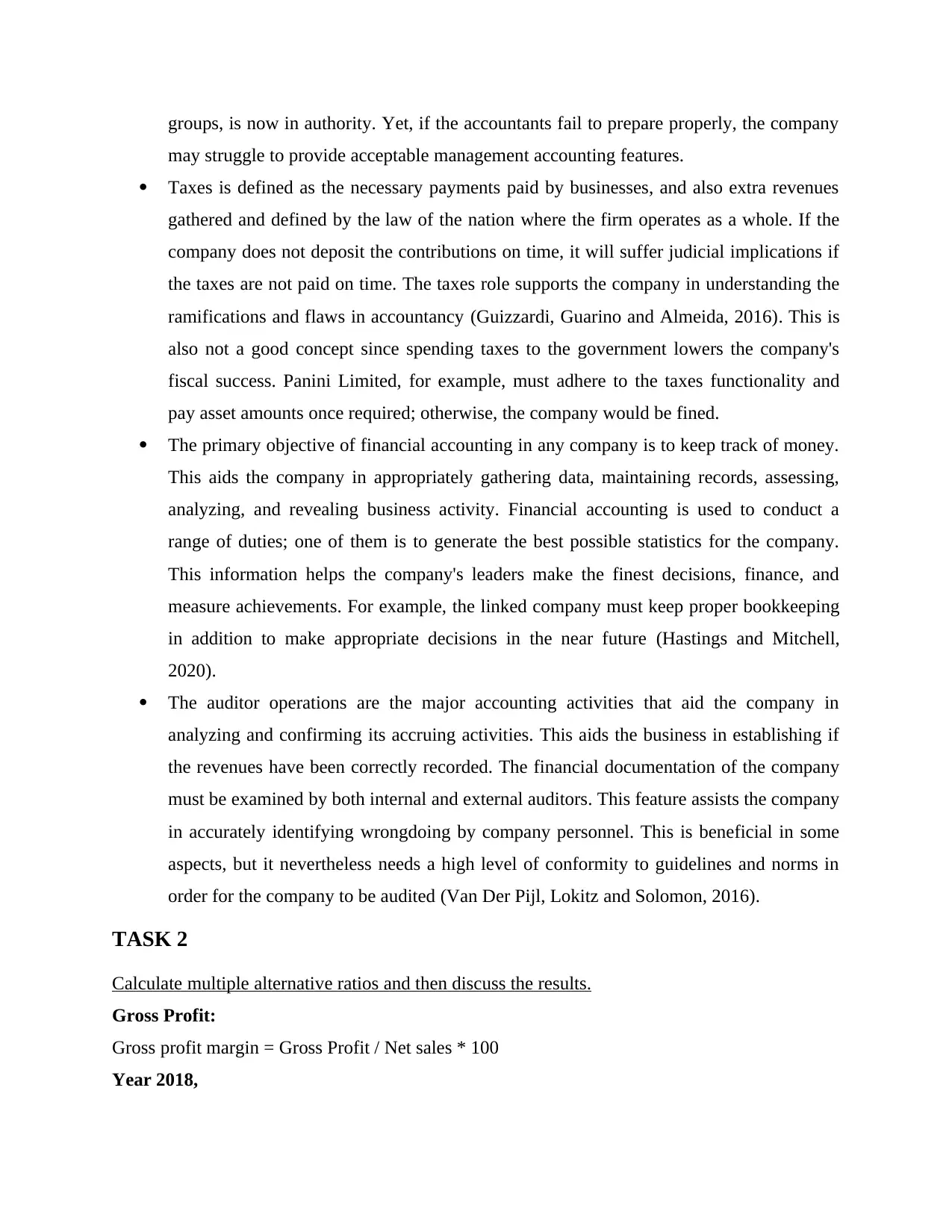
groups, is now in authority. Yet, if the accountants fail to prepare properly, the company
may struggle to provide acceptable management accounting features.
Taxes is defined as the necessary payments paid by businesses, and also extra revenues
gathered and defined by the law of the nation where the firm operates as a whole. If the
company does not deposit the contributions on time, it will suffer judicial implications if
the taxes are not paid on time. The taxes role supports the company in understanding the
ramifications and flaws in accountancy (Guizzardi, Guarino and Almeida, 2016). This is
also not a good concept since spending taxes to the government lowers the company's
fiscal success. Panini Limited, for example, must adhere to the taxes functionality and
pay asset amounts once required; otherwise, the company would be fined.
The primary objective of financial accounting in any company is to keep track of money.
This aids the company in appropriately gathering data, maintaining records, assessing,
analyzing, and revealing business activity. Financial accounting is used to conduct a
range of duties; one of them is to generate the best possible statistics for the company.
This information helps the company's leaders make the finest decisions, finance, and
measure achievements. For example, the linked company must keep proper bookkeeping
in addition to make appropriate decisions in the near future (Hastings and Mitchell,
2020).
The auditor operations are the major accounting activities that aid the company in
analyzing and confirming its accruing activities. This aids the business in establishing if
the revenues have been correctly recorded. The financial documentation of the company
must be examined by both internal and external auditors. This feature assists the company
in accurately identifying wrongdoing by company personnel. This is beneficial in some
aspects, but it nevertheless needs a high level of conformity to guidelines and norms in
order for the company to be audited (Van Der Pijl, Lokitz and Solomon, 2016).
TASK 2
Calculate multiple alternative ratios and then discuss the results.
Gross Profit:
Gross profit margin = Gross Profit / Net sales * 100
Year 2018,
may struggle to provide acceptable management accounting features.
Taxes is defined as the necessary payments paid by businesses, and also extra revenues
gathered and defined by the law of the nation where the firm operates as a whole. If the
company does not deposit the contributions on time, it will suffer judicial implications if
the taxes are not paid on time. The taxes role supports the company in understanding the
ramifications and flaws in accountancy (Guizzardi, Guarino and Almeida, 2016). This is
also not a good concept since spending taxes to the government lowers the company's
fiscal success. Panini Limited, for example, must adhere to the taxes functionality and
pay asset amounts once required; otherwise, the company would be fined.
The primary objective of financial accounting in any company is to keep track of money.
This aids the company in appropriately gathering data, maintaining records, assessing,
analyzing, and revealing business activity. Financial accounting is used to conduct a
range of duties; one of them is to generate the best possible statistics for the company.
This information helps the company's leaders make the finest decisions, finance, and
measure achievements. For example, the linked company must keep proper bookkeeping
in addition to make appropriate decisions in the near future (Hastings and Mitchell,
2020).
The auditor operations are the major accounting activities that aid the company in
analyzing and confirming its accruing activities. This aids the business in establishing if
the revenues have been correctly recorded. The financial documentation of the company
must be examined by both internal and external auditors. This feature assists the company
in accurately identifying wrongdoing by company personnel. This is beneficial in some
aspects, but it nevertheless needs a high level of conformity to guidelines and norms in
order for the company to be audited (Van Der Pijl, Lokitz and Solomon, 2016).
TASK 2
Calculate multiple alternative ratios and then discuss the results.
Gross Profit:
Gross profit margin = Gross Profit / Net sales * 100
Year 2018,
Paraphrase This Document
Need a fresh take? Get an instant paraphrase of this document with our AI Paraphraser
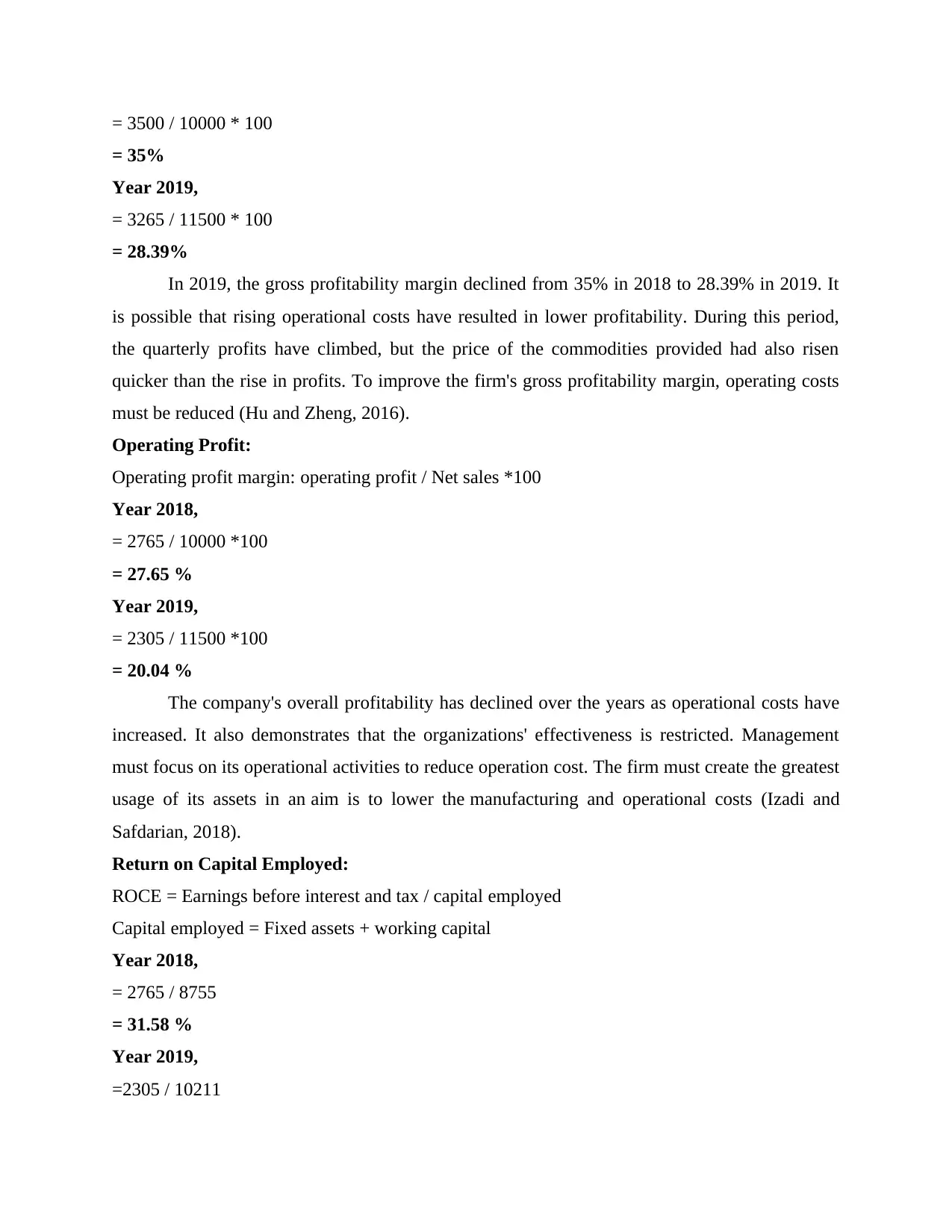
= 3500 / 10000 * 100
= 35%
Year 2019,
= 3265 / 11500 * 100
= 28.39%
In 2019, the gross profitability margin declined from 35% in 2018 to 28.39% in 2019. It
is possible that rising operational costs have resulted in lower profitability. During this period,
the quarterly profits have climbed, but the price of the commodities provided had also risen
quicker than the rise in profits. To improve the firm's gross profitability margin, operating costs
must be reduced (Hu and Zheng, 2016).
Operating Profit:
Operating profit margin: operating profit / Net sales *100
Year 2018,
= 2765 / 10000 *100
= 27.65 %
Year 2019,
= 2305 / 11500 *100
= 20.04 %
The company's overall profitability has declined over the years as operational costs have
increased. It also demonstrates that the organizations' effectiveness is restricted. Management
must focus on its operational activities to reduce operation cost. The firm must create the greatest
usage of its assets in an aim is to lower the manufacturing and operational costs (Izadi and
Safdarian, 2018).
Return on Capital Employed:
ROCE = Earnings before interest and tax / capital employed
Capital employed = Fixed assets + working capital
Year 2018,
= 2765 / 8755
= 31.58 %
Year 2019,
=2305 / 10211
= 35%
Year 2019,
= 3265 / 11500 * 100
= 28.39%
In 2019, the gross profitability margin declined from 35% in 2018 to 28.39% in 2019. It
is possible that rising operational costs have resulted in lower profitability. During this period,
the quarterly profits have climbed, but the price of the commodities provided had also risen
quicker than the rise in profits. To improve the firm's gross profitability margin, operating costs
must be reduced (Hu and Zheng, 2016).
Operating Profit:
Operating profit margin: operating profit / Net sales *100
Year 2018,
= 2765 / 10000 *100
= 27.65 %
Year 2019,
= 2305 / 11500 *100
= 20.04 %
The company's overall profitability has declined over the years as operational costs have
increased. It also demonstrates that the organizations' effectiveness is restricted. Management
must focus on its operational activities to reduce operation cost. The firm must create the greatest
usage of its assets in an aim is to lower the manufacturing and operational costs (Izadi and
Safdarian, 2018).
Return on Capital Employed:
ROCE = Earnings before interest and tax / capital employed
Capital employed = Fixed assets + working capital
Year 2018,
= 2765 / 8755
= 31.58 %
Year 2019,
=2305 / 10211
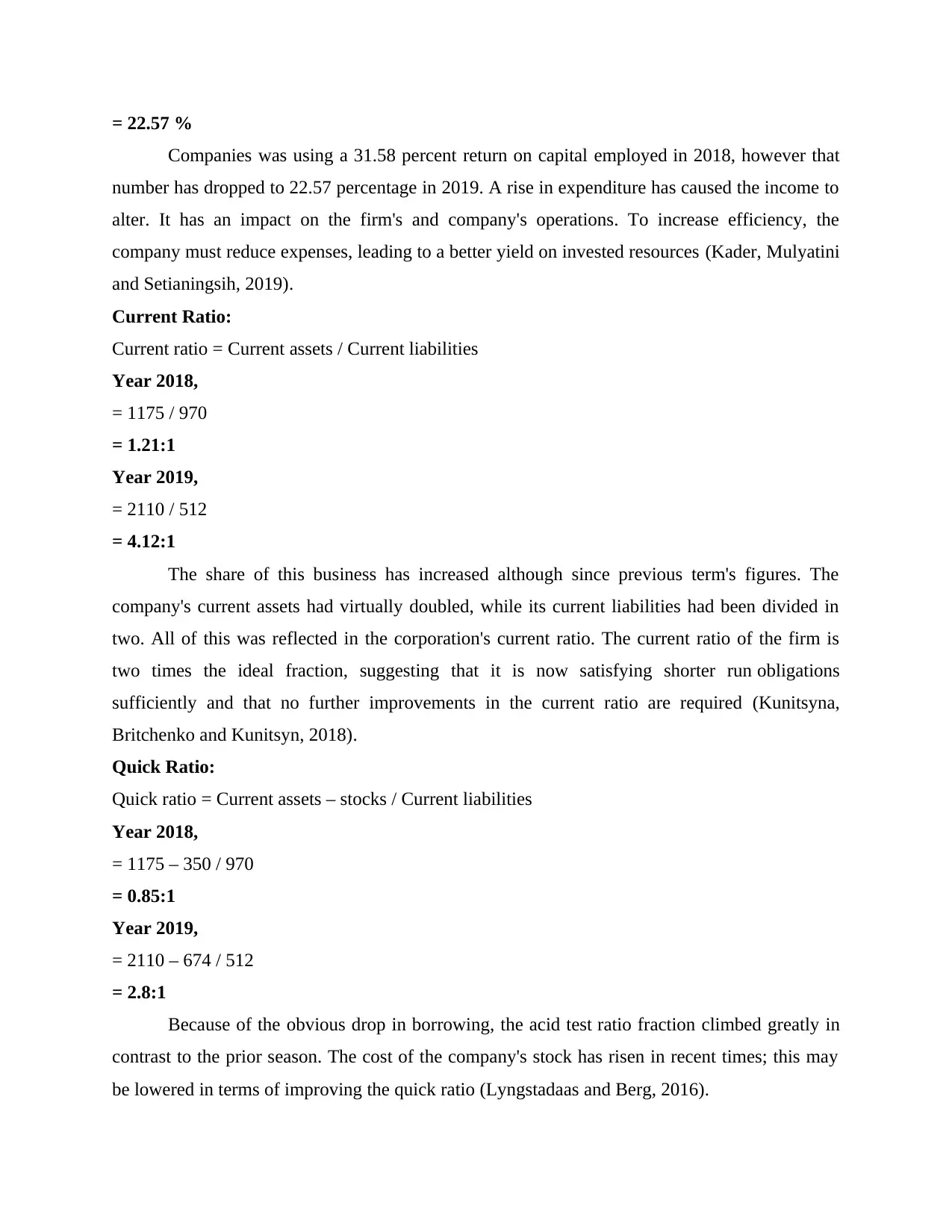
= 22.57 %
Companies was using a 31.58 percent return on capital employed in 2018, however that
number has dropped to 22.57 percentage in 2019. A rise in expenditure has caused the income to
alter. It has an impact on the firm's and company's operations. To increase efficiency, the
company must reduce expenses, leading to a better yield on invested resources (Kader, Mulyatini
and Setianingsih, 2019).
Current Ratio:
Current ratio = Current assets / Current liabilities
Year 2018,
= 1175 / 970
= 1.21:1
Year 2019,
= 2110 / 512
= 4.12:1
The share of this business has increased although since previous term's figures. The
company's current assets had virtually doubled, while its current liabilities had been divided in
two. All of this was reflected in the corporation's current ratio. The current ratio of the firm is
two times the ideal fraction, suggesting that it is now satisfying shorter run obligations
sufficiently and that no further improvements in the current ratio are required (Kunitsyna,
Britchenko and Kunitsyn, 2018).
Quick Ratio:
Quick ratio = Current assets – stocks / Current liabilities
Year 2018,
= 1175 – 350 / 970
= 0.85:1
Year 2019,
= 2110 – 674 / 512
= 2.8:1
Because of the obvious drop in borrowing, the acid test ratio fraction climbed greatly in
contrast to the prior season. The cost of the company's stock has risen in recent times; this may
be lowered in terms of improving the quick ratio (Lyngstadaas and Berg, 2016).
Companies was using a 31.58 percent return on capital employed in 2018, however that
number has dropped to 22.57 percentage in 2019. A rise in expenditure has caused the income to
alter. It has an impact on the firm's and company's operations. To increase efficiency, the
company must reduce expenses, leading to a better yield on invested resources (Kader, Mulyatini
and Setianingsih, 2019).
Current Ratio:
Current ratio = Current assets / Current liabilities
Year 2018,
= 1175 / 970
= 1.21:1
Year 2019,
= 2110 / 512
= 4.12:1
The share of this business has increased although since previous term's figures. The
company's current assets had virtually doubled, while its current liabilities had been divided in
two. All of this was reflected in the corporation's current ratio. The current ratio of the firm is
two times the ideal fraction, suggesting that it is now satisfying shorter run obligations
sufficiently and that no further improvements in the current ratio are required (Kunitsyna,
Britchenko and Kunitsyn, 2018).
Quick Ratio:
Quick ratio = Current assets – stocks / Current liabilities
Year 2018,
= 1175 – 350 / 970
= 0.85:1
Year 2019,
= 2110 – 674 / 512
= 2.8:1
Because of the obvious drop in borrowing, the acid test ratio fraction climbed greatly in
contrast to the prior season. The cost of the company's stock has risen in recent times; this may
be lowered in terms of improving the quick ratio (Lyngstadaas and Berg, 2016).
⊘ This is a preview!⊘
Do you want full access?
Subscribe today to unlock all pages.

Trusted by 1+ million students worldwide
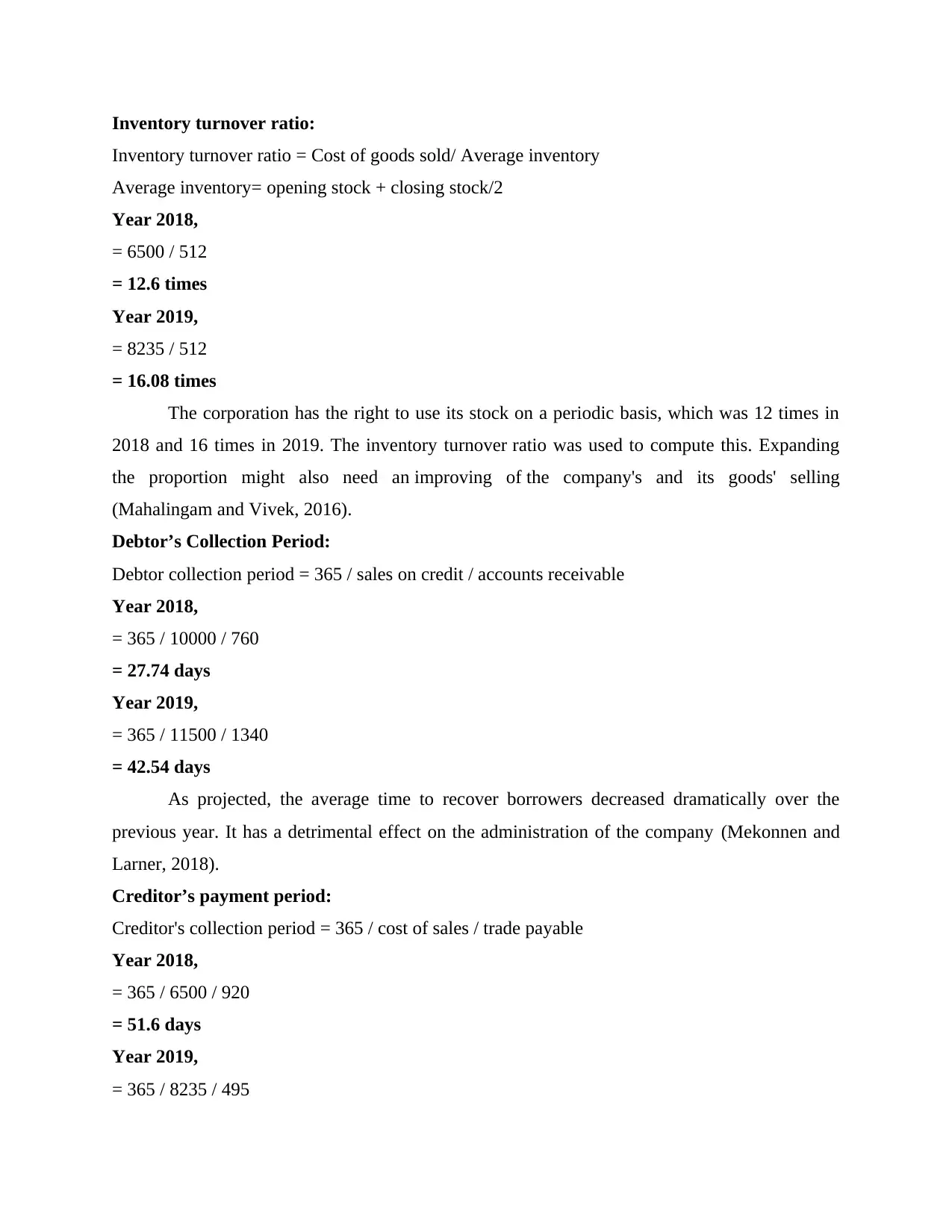
Inventory turnover ratio:
Inventory turnover ratio = Cost of goods sold/ Average inventory
Average inventory= opening stock + closing stock/2
Year 2018,
= 6500 / 512
= 12.6 times
Year 2019,
= 8235 / 512
= 16.08 times
The corporation has the right to use its stock on a periodic basis, which was 12 times in
2018 and 16 times in 2019. The inventory turnover ratio was used to compute this. Expanding
the proportion might also need an improving of the company's and its goods' selling
(Mahalingam and Vivek, 2016).
Debtor’s Collection Period:
Debtor collection period = 365 / sales on credit / accounts receivable
Year 2018,
= 365 / 10000 / 760
= 27.74 days
Year 2019,
= 365 / 11500 / 1340
= 42.54 days
As projected, the average time to recover borrowers decreased dramatically over the
previous year. It has a detrimental effect on the administration of the company (Mekonnen and
Larner, 2018).
Creditor’s payment period:
Creditor's collection period = 365 / cost of sales / trade payable
Year 2018,
= 365 / 6500 / 920
= 51.6 days
Year 2019,
= 365 / 8235 / 495
Inventory turnover ratio = Cost of goods sold/ Average inventory
Average inventory= opening stock + closing stock/2
Year 2018,
= 6500 / 512
= 12.6 times
Year 2019,
= 8235 / 512
= 16.08 times
The corporation has the right to use its stock on a periodic basis, which was 12 times in
2018 and 16 times in 2019. The inventory turnover ratio was used to compute this. Expanding
the proportion might also need an improving of the company's and its goods' selling
(Mahalingam and Vivek, 2016).
Debtor’s Collection Period:
Debtor collection period = 365 / sales on credit / accounts receivable
Year 2018,
= 365 / 10000 / 760
= 27.74 days
Year 2019,
= 365 / 11500 / 1340
= 42.54 days
As projected, the average time to recover borrowers decreased dramatically over the
previous year. It has a detrimental effect on the administration of the company (Mekonnen and
Larner, 2018).
Creditor’s payment period:
Creditor's collection period = 365 / cost of sales / trade payable
Year 2018,
= 365 / 6500 / 920
= 51.6 days
Year 2019,
= 365 / 8235 / 495
Paraphrase This Document
Need a fresh take? Get an instant paraphrase of this document with our AI Paraphraser
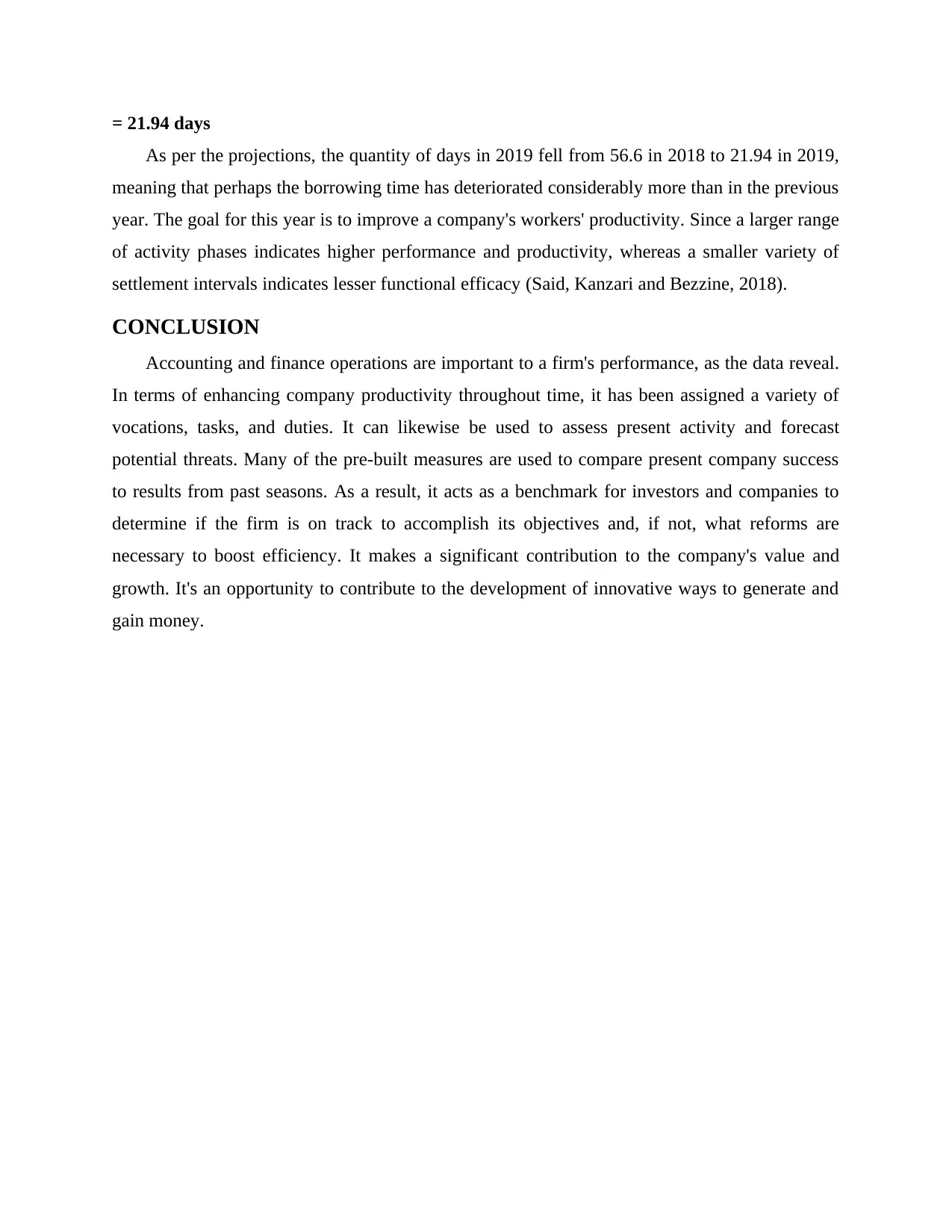
= 21.94 days
As per the projections, the quantity of days in 2019 fell from 56.6 in 2018 to 21.94 in 2019,
meaning that perhaps the borrowing time has deteriorated considerably more than in the previous
year. The goal for this year is to improve a company's workers' productivity. Since a larger range
of activity phases indicates higher performance and productivity, whereas a smaller variety of
settlement intervals indicates lesser functional efficacy (Said, Kanzari and Bezzine, 2018).
CONCLUSION
Accounting and finance operations are important to a firm's performance, as the data reveal.
In terms of enhancing company productivity throughout time, it has been assigned a variety of
vocations, tasks, and duties. It can likewise be used to assess present activity and forecast
potential threats. Many of the pre-built measures are used to compare present company success
to results from past seasons. As a result, it acts as a benchmark for investors and companies to
determine if the firm is on track to accomplish its objectives and, if not, what reforms are
necessary to boost efficiency. It makes a significant contribution to the company's value and
growth. It's an opportunity to contribute to the development of innovative ways to generate and
gain money.
As per the projections, the quantity of days in 2019 fell from 56.6 in 2018 to 21.94 in 2019,
meaning that perhaps the borrowing time has deteriorated considerably more than in the previous
year. The goal for this year is to improve a company's workers' productivity. Since a larger range
of activity phases indicates higher performance and productivity, whereas a smaller variety of
settlement intervals indicates lesser functional efficacy (Said, Kanzari and Bezzine, 2018).
CONCLUSION
Accounting and finance operations are important to a firm's performance, as the data reveal.
In terms of enhancing company productivity throughout time, it has been assigned a variety of
vocations, tasks, and duties. It can likewise be used to assess present activity and forecast
potential threats. Many of the pre-built measures are used to compare present company success
to results from past seasons. As a result, it acts as a benchmark for investors and companies to
determine if the firm is on track to accomplish its objectives and, if not, what reforms are
necessary to boost efficiency. It makes a significant contribution to the company's value and
growth. It's an opportunity to contribute to the development of innovative ways to generate and
gain money.
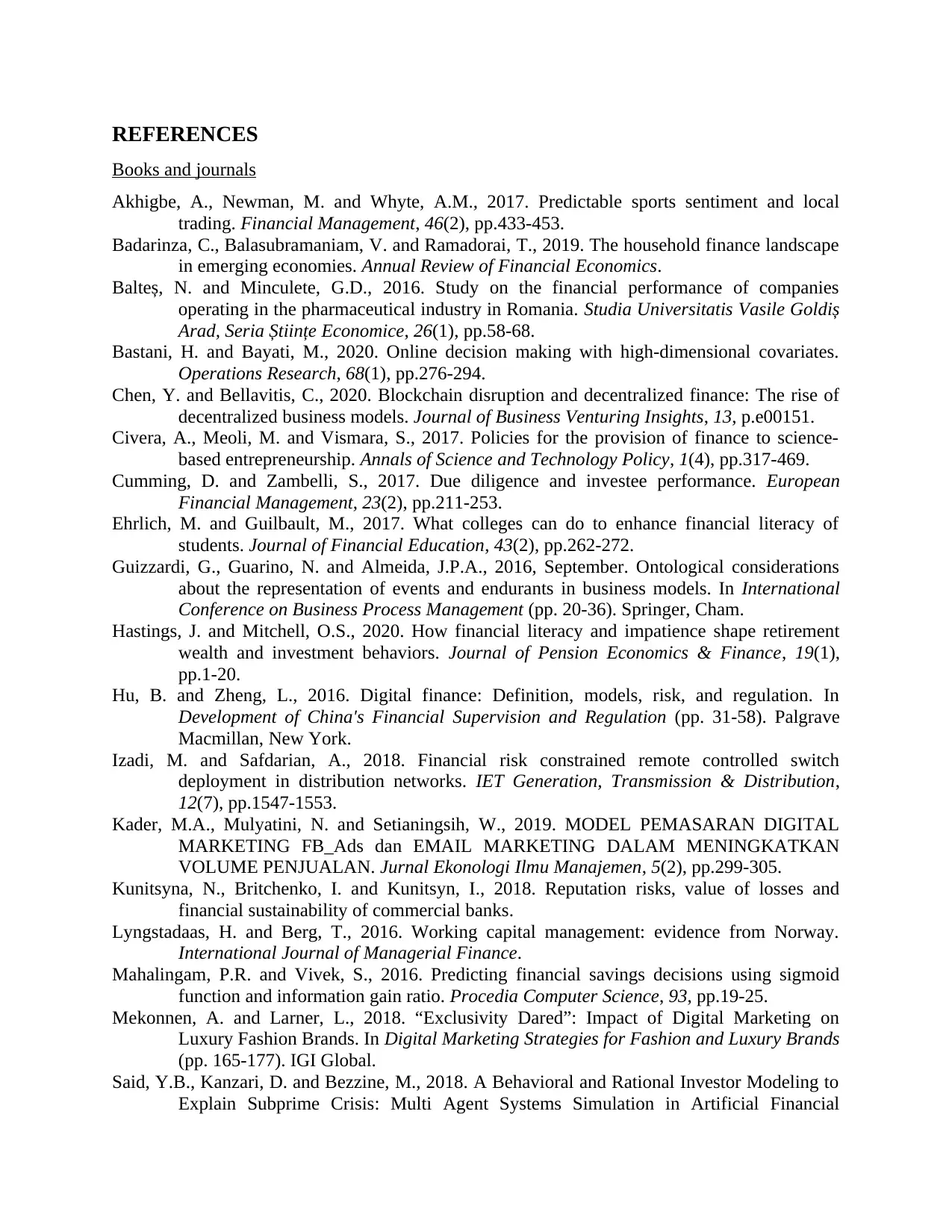
REFERENCES
Books and journals
Akhigbe, A., Newman, M. and Whyte, A.M., 2017. Predictable sports sentiment and local
trading. Financial Management, 46(2), pp.433-453.
Badarinza, C., Balasubramaniam, V. and Ramadorai, T., 2019. The household finance landscape
in emerging economies. Annual Review of Financial Economics.
Balteș, N. and Minculete, G.D., 2016. Study on the financial performance of companies
operating in the pharmaceutical industry in Romania. Studia Universitatis Vasile Goldiș
Arad, Seria Științe Economice, 26(1), pp.58-68.
Bastani, H. and Bayati, M., 2020. Online decision making with high-dimensional covariates.
Operations Research, 68(1), pp.276-294.
Chen, Y. and Bellavitis, C., 2020. Blockchain disruption and decentralized finance: The rise of
decentralized business models. Journal of Business Venturing Insights, 13, p.e00151.
Civera, A., Meoli, M. and Vismara, S., 2017. Policies for the provision of finance to science-
based entrepreneurship. Annals of Science and Technology Policy, 1(4), pp.317-469.
Cumming, D. and Zambelli, S., 2017. Due diligence and investee performance. European
Financial Management, 23(2), pp.211-253.
Ehrlich, M. and Guilbault, M., 2017. What colleges can do to enhance financial literacy of
students. Journal of Financial Education, 43(2), pp.262-272.
Guizzardi, G., Guarino, N. and Almeida, J.P.A., 2016, September. Ontological considerations
about the representation of events and endurants in business models. In International
Conference on Business Process Management (pp. 20-36). Springer, Cham.
Hastings, J. and Mitchell, O.S., 2020. How financial literacy and impatience shape retirement
wealth and investment behaviors. Journal of Pension Economics & Finance, 19(1),
pp.1-20.
Hu, B. and Zheng, L., 2016. Digital finance: Definition, models, risk, and regulation. In
Development of China's Financial Supervision and Regulation (pp. 31-58). Palgrave
Macmillan, New York.
Izadi, M. and Safdarian, A., 2018. Financial risk constrained remote controlled switch
deployment in distribution networks. IET Generation, Transmission & Distribution,
12(7), pp.1547-1553.
Kader, M.A., Mulyatini, N. and Setianingsih, W., 2019. MODEL PEMASARAN DIGITAL
MARKETING FB_Ads dan EMAIL MARKETING DALAM MENINGKATKAN
VOLUME PENJUALAN. Jurnal Ekonologi Ilmu Manajemen, 5(2), pp.299-305.
Kunitsyna, N., Britchenko, I. and Kunitsyn, I., 2018. Reputation risks, value of losses and
financial sustainability of commercial banks.
Lyngstadaas, H. and Berg, T., 2016. Working capital management: evidence from Norway.
International Journal of Managerial Finance.
Mahalingam, P.R. and Vivek, S., 2016. Predicting financial savings decisions using sigmoid
function and information gain ratio. Procedia Computer Science, 93, pp.19-25.
Mekonnen, A. and Larner, L., 2018. “Exclusivity Dared”: Impact of Digital Marketing on
Luxury Fashion Brands. In Digital Marketing Strategies for Fashion and Luxury Brands
(pp. 165-177). IGI Global.
Said, Y.B., Kanzari, D. and Bezzine, M., 2018. A Behavioral and Rational Investor Modeling to
Explain Subprime Crisis: Multi Agent Systems Simulation in Artificial Financial
Books and journals
Akhigbe, A., Newman, M. and Whyte, A.M., 2017. Predictable sports sentiment and local
trading. Financial Management, 46(2), pp.433-453.
Badarinza, C., Balasubramaniam, V. and Ramadorai, T., 2019. The household finance landscape
in emerging economies. Annual Review of Financial Economics.
Balteș, N. and Minculete, G.D., 2016. Study on the financial performance of companies
operating in the pharmaceutical industry in Romania. Studia Universitatis Vasile Goldiș
Arad, Seria Științe Economice, 26(1), pp.58-68.
Bastani, H. and Bayati, M., 2020. Online decision making with high-dimensional covariates.
Operations Research, 68(1), pp.276-294.
Chen, Y. and Bellavitis, C., 2020. Blockchain disruption and decentralized finance: The rise of
decentralized business models. Journal of Business Venturing Insights, 13, p.e00151.
Civera, A., Meoli, M. and Vismara, S., 2017. Policies for the provision of finance to science-
based entrepreneurship. Annals of Science and Technology Policy, 1(4), pp.317-469.
Cumming, D. and Zambelli, S., 2017. Due diligence and investee performance. European
Financial Management, 23(2), pp.211-253.
Ehrlich, M. and Guilbault, M., 2017. What colleges can do to enhance financial literacy of
students. Journal of Financial Education, 43(2), pp.262-272.
Guizzardi, G., Guarino, N. and Almeida, J.P.A., 2016, September. Ontological considerations
about the representation of events and endurants in business models. In International
Conference on Business Process Management (pp. 20-36). Springer, Cham.
Hastings, J. and Mitchell, O.S., 2020. How financial literacy and impatience shape retirement
wealth and investment behaviors. Journal of Pension Economics & Finance, 19(1),
pp.1-20.
Hu, B. and Zheng, L., 2016. Digital finance: Definition, models, risk, and regulation. In
Development of China's Financial Supervision and Regulation (pp. 31-58). Palgrave
Macmillan, New York.
Izadi, M. and Safdarian, A., 2018. Financial risk constrained remote controlled switch
deployment in distribution networks. IET Generation, Transmission & Distribution,
12(7), pp.1547-1553.
Kader, M.A., Mulyatini, N. and Setianingsih, W., 2019. MODEL PEMASARAN DIGITAL
MARKETING FB_Ads dan EMAIL MARKETING DALAM MENINGKATKAN
VOLUME PENJUALAN. Jurnal Ekonologi Ilmu Manajemen, 5(2), pp.299-305.
Kunitsyna, N., Britchenko, I. and Kunitsyn, I., 2018. Reputation risks, value of losses and
financial sustainability of commercial banks.
Lyngstadaas, H. and Berg, T., 2016. Working capital management: evidence from Norway.
International Journal of Managerial Finance.
Mahalingam, P.R. and Vivek, S., 2016. Predicting financial savings decisions using sigmoid
function and information gain ratio. Procedia Computer Science, 93, pp.19-25.
Mekonnen, A. and Larner, L., 2018. “Exclusivity Dared”: Impact of Digital Marketing on
Luxury Fashion Brands. In Digital Marketing Strategies for Fashion and Luxury Brands
(pp. 165-177). IGI Global.
Said, Y.B., Kanzari, D. and Bezzine, M., 2018. A Behavioral and Rational Investor Modeling to
Explain Subprime Crisis: Multi Agent Systems Simulation in Artificial Financial
⊘ This is a preview!⊘
Do you want full access?
Subscribe today to unlock all pages.

Trusted by 1+ million students worldwide
1 out of 13
Related Documents
Your All-in-One AI-Powered Toolkit for Academic Success.
+13062052269
info@desklib.com
Available 24*7 on WhatsApp / Email
![[object Object]](/_next/static/media/star-bottom.7253800d.svg)
Unlock your academic potential
Copyright © 2020–2025 A2Z Services. All Rights Reserved. Developed and managed by ZUCOL.
